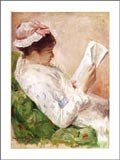I never leave the house without a red ribbon.
Mary Saunders, the focus of Slammerkin, is thrown out
of her house after being raped for her desire for a red ribbon.
Does the red ribbon establish a kinship between Mary and
me? Perhaps. Lacking a common desire or situation, the
reader may have difficulty opening herself to a character
– in my case, the relationship between a middle-aged
librarian and a doomed teenaged prostitute.
Slammerkin places a very young woman in a desperately
poor household, where she is neither loved nor consulted
about how her life will unfold.
All evidence points to a miserable and colorless
continuation of her mother’s life of poverty, drudgery,
and subjugation that was sealed when her father
was killed in a misguided protest by men who believed that
they were going to lose, literally lose, eleven days of their
lives when the government changed to the Gregorian
calendar in 1752 -that they would lose time.
I was fascinated by the subjective inconstancy of Mary’s
perception of time. In her mother’s house, time is nearly a
solid mass, changing only by suffering and the family’s
heartless response to Mary’s pregnancy. This response, a
product of the times, is doled out without mercy.
How could the family understand the depth of Mary’s need
to escape the faded beige of their lives, or the magical hope
symbolized by that red ribbon? And yet, how could a mother
cast out her raped, pregnant daughter?
(As I write, I realize that Mary’s mother is the only truly
unforgivable character in the book. Perhaps my modern-time
sensibility intrudes. All of the subsequent damage and
tragedy that defined Mary’s brief time, and all of the bitter
focus on the actual material that she craved in this world,
began with this primal betrayal. If she was not loved for
what was within, she could, at least, adorn herself with the transitory beauty of clothes.)
Time, and the times, were different when Mary fled
to London. London was fast-paced, and the woman who
accepted her into the sisterhood of prostitutes were fast.
Doll’s love and practical guidance showed Mary that society
can tolerate – even require – actions and beliefs far larger
than she had ever imagined. Through prostitution, Mary
acquired financial independence and freedom to see some of
thewonders of her modern world. Likethe fireworks over
London, she and her sisters of the night were brief flashes
of beauty, dressed in their colorful slammerkins (loose
dresses) and masked behind their paint.
Mary’s sudden need to escape a street thug impelled her
to Magdalene Hospital, a residence founded to purge the
evil from the street-wise women. Time was suspended there,
with silence, blandness, and time to think without fearing
starvation or death in the freezing streets. With Doll’s death,
Mary realizes that she has to leave London, and her
retreat ends in a desperate flight from the sanctuary
to the town where her mother had grown up. Glimpses
of the possibilities there almost melt her cynicism, but
her nature has been formed, and she can not escape.
This novel is based, loosely, on the actual life of a Mary
Saunders who was executed for murder in 1764. From the
beginning of the novel, when Mary is 13, to her death by
hanging at age 16, Mary passes through more lifetimes
than many experience in ten times the years.
How many such lifetimes can a child endure? For Mary is a
child, and my working-class perception of childhood
makes me ache for this young girl, whose only
transgression was the love of a piece of red ribbon.
How does the red ribbon bind me to Mary’s life? For both the
18th -century child and the 21st century woman, the red
ribbon symbolizes hope. Mary’s hope for a better life is
destroyed, but the hopes of my Eastern European Jewish
ancestors for the children who would be born in the new
world, and would escape the Evil Eye of the old. have
been realized. After reading Slammerkin, I realize anew
that I am, indeed, blessed.
8.28.2008
Subscribe to:
Post Comments (Atom)


No comments:
Post a Comment